Study on Strategies to Implement Adaptation Measures for Extreme High Temperatures into the Street Canyon
Abstract
:1. Introduction
2. Calculation Methods and Results
2.1. Objective Area
2.2. Calculation Results
3. Results and Discussion
3.1. Spatiotemporal Distribution of SET* in Road Space
3.2. Effects of Water Sprinkling
3.3. Effects of Water Surface
3.4. Effects of Sunshade
3.5. Effects of Street Tree
3.6. Discussion
- -
- Regarding mist spray, is it acceptable for mist to wet the human body? It may be acceptable at parks where leisure is the main purpose, but may not be acceptable at bus stops where business is the main purpose.
- -
- Regarding water surface, is it acceptable to have a walking space on the water surface? It may depend on the condition of the pedestrian’s shoes and clothing.
- -
- Regarding watering pavement, is it acceptable that the pavement underfoot is wet? It may depend on the condition of the pedestrian’s shoes, etc.
- -
- Regarding watering road, is it possible to supply water up to the edge of the road? Coordination with roadway management and operations is necessary.
- -
- Regarding street trees, is it possible to maintain the trees, such as pruning? The understanding and cooperation of neighborhood residents is necessary.
- -
- Regarding sunshade, is it possible to match the shade area with the location of visitors? Appropriate solar radiation shading should be planned according to the use of the target space.
4. Conclusions
Author Contributions
Funding
Institutional Review Board Statement
Informed Consent Statement
Data Availability Statement
Acknowledgments
Conflicts of Interest
References
- Takebayashi, H.; Danno, H.; Tozawa, U. Study on appropriate heat mitigation technologies for urban block redevelopment based on demonstration experiments in Kobe city. Energy Build. 2021, 250, 111299. [Google Scholar] [CrossRef]
- Heat Countermeasure Guideline in the City. Available online: https://www.wbgt.env.go.jp/pdf/city_gline/city_guideline_full.pdf (accessed on 6 May 2022).
- Walkable Portal Site. Available online: https://www.mlit.go.jp/toshi/walkable/ (accessed on 6 May 2022).
- Takebayashi, H. A Simple Method to Evaluate Adaptation Measures for Urban Heat Island. Environments 2018, 5, 70. [Google Scholar] [CrossRef] [Green Version]
- Broadbent, A.M.; Coutts, A.M.; Tapper, N.J.; Demuzere, M. The cooling effect of irrigation on urban microclimate during heatwave conditions. Urban Clim. 2018, 23, 309–329. [Google Scholar] [CrossRef]
- Daniel, M.; Lemonsu, A.; Viguié, V. Role of watering practices in large-scale urban planning strategies to face the heat-wave risk in future climate. Urban Clim. 2018, 23, 287–308. [Google Scholar] [CrossRef]
- De Munck, C.; Lemonsu, A.; Masson, V.; Le Bras, J.; Bonhomme, M. Evaluating the impacts of greening scenarios on thermal comfort and energy and water consumptions for adapting Paris city to climate change. Urban Clim. 2018, 23, 260–286. [Google Scholar] [CrossRef] [Green Version]
- Baklanov, A.; Grimmond, C.S.B.; Carlson, D.; Terblanche, D.; Tang, X.; Bouchet, V.; Lee, B.; Langendijk, G.; Kolli, R.K.; Hovsepyan, A. From urban meteorology, climate and environment research to integrated city services. Urban Clim. 2018, 23, 330–341. [Google Scholar] [CrossRef]
- Gao, Z.; Bresson, R.; Qu, Y.; Milliez, M.; Munck, C.; Carissimo, B. High resolution unsteady RANS simulation of wind, thermal effects and pollution dispersion for studying urban renewal scenarios in a neighborhood of Toulouse. Urban Clim. 2018, 23, 114–130. [Google Scholar] [CrossRef]
- Ng, E.; Ren, C. China’s adaptation to climate & urban climatic changes: A critical review. Urban Clim. 2018, 23, 352–372. [Google Scholar]
- Givoni, B.; Noguchi, M.; Saaroni, H.; Potchter, O.; Yaacov, Y.; Feller, N.; Becker, S. Outdoor comfort research issues. Energy Build. 2003, 35, 77–86. [Google Scholar] [CrossRef]
- Andrade, H.; Alcoforado, M.J.; Oliveira, S. Perception of temperature and wind by users of public outdoor spaces: Relationships with weather parameters and personal characteristics. Int. J. Biometeorol. 2011, 55, 665–680. [Google Scholar] [CrossRef]
- Johansson, E.; Thorsson, S.; Emmanuel, R.; Krüger, E. Instruments and methods in outdoor thermal comfort studies—The need for standardization. Urban Clim. 2014, 10, 346–366. [Google Scholar] [CrossRef] [Green Version]
- Ketterer, C.; Matzarakis, A. Human-biometeorological assessment of the urban heat island in a city with complex topography—The case of Stuttgart, Germany. Urban Clim. 2014, 10, 573–584. [Google Scholar] [CrossRef]
- Stavrakakis, G.M.; Tzanakic, E.; Genetzaki, V.I.; Anagnostakis, G.; Galetakis, G.; Grigorakis, E. A computational methodology for effective bioclimatic-design applications in the urban environment. Sustain. Cities Soc. 2012, 4, 41–57. [Google Scholar] [CrossRef] [Green Version]
- Yang, X.; Zhao, L.; Bruse, M.; Meng, Q. Evaluation of a microclimate model for predicting the thermal behavior of different ground. Build. Environ. 2013, 60, 93–104. [Google Scholar] [CrossRef]
- Fabbri, K.; Di Nunzio, A.; Gaspari, J.; Antonini, E.; Boeri, A. Outdoor Comfort: The ENVI-BUG tool to evaluate PMV values Output Comfort point by point. Energy Procedia 2017, 111, 510–519. [Google Scholar] [CrossRef]
- Forouzandeh, A. Numerical modeling validation for the microclimate thermal condition of semi-closed courtyard spaces between buildings. Sustain. Cities Soc. 2018, 36, 327–345. [Google Scholar] [CrossRef]
- Shashua-Bar, L.; Pearlmutter, D.; Erell, E. The influence of trees and grass on outdoor thermal comfort in a hot-arid environment. Int. J. Climatol. 2011, 31, 1498–1506. [Google Scholar] [CrossRef]
- Taleghani, M.; Kleerekper, L.; Tenpierik, M.; van den Dobbelsteen, A. Outdoor thermal comfort within five different urban forms in the Netherlands. Build. Environ. 2015, 83, 65–78. [Google Scholar] [CrossRef]
- Jamei, E.; Rajagopalan, P.; Seyedmahmoudian, M.; Jamei, Y. Review on the impact of urban geometry and pedestrian level greening on outdoor thermal comfort. Renew. Sustain. Energy Rev. 2016, 54, 1002–1017. [Google Scholar] [CrossRef]
- Wang, Z.H.; Zhao, X.; Yang, J.; Song, J. Cooling and energy saving potentials of shade trees and urban lawns in a desert city. Appl. Energy 2016, 161, 437–444. [Google Scholar] [CrossRef]
- Hendel, M.; Gutierrez, P.; Colombert, M.; Diab, Y.; Royon, L. Measuring the effects of urban heat island mitigation techniques in the field: Application to the case of pavement-watering in Paris. Urban Clim. 2016, 16, 43–58. [Google Scholar] [CrossRef]
- Gaspari, J.; Fabbri, K. A study on the use of outdoor microclimate map to address design solutions for urban regeneration. Energy Procedia 2017, 111, 500–509. [Google Scholar] [CrossRef]
- Gaspari, J.; Fabbri, K.; Lucchi, M. The use of outdoor microclimate analysis to support decision making process: Case study of Bufalini square in Cesena. Sustain. Cities Soc. 2018, 42, 206–215. [Google Scholar] [CrossRef]
- Beermann, B.; Berchtold, M.; Baumüller, J.; Gross, G.; Kratz, M. Städtebaulicher Rahmenplan Klimaanpassung für die Stadt Karlsruhe (Teil II); LUBW Landesanstalt für Umwelt, Messungen und Naturschutz Baden-Württemberg: Karlsruhe, Germany, 2014. [Google Scholar]
- Baumueller, J.; Hoffmann, U.; Reuter, U. Climate Booklet for Urban Development; Ministry of Economy Baden-Wuerttemberg, Environmental Protection Development: Stuttgart, Germany, 1992.
- Ren, C.; Ng, E.; Katzschner, L. Urban climatic map studies: A review. Int. J. Climatol. 2011, 31, 2213–2233. [Google Scholar] [CrossRef]
- Takebayashi, H.; Okubo, M.; Danno, H. Thermal environment map in street canyon for implementing extreme high temperature measures. Atmosphere 2020, 11, 550. [Google Scholar] [CrossRef]
- Takebayashi, H.; Ishii, E.; Moriyama, M.; Sakaki, A.; Nakajima, S.; Ueda, H. Study to examine the potential for solar energy utilization based on the relationship between urban morphology and solar radiation gain on building rooftops and wall surfaces. Sol. Energy 2015, 119, 362–369. [Google Scholar] [CrossRef]
- Ishii, A.; Katayama, T.; Shiotsuki, Y.; Yoshimizu, H.; Abe, Y. Experimental study on comfort sensation of people in the outdoor environment. J. Archit. Plan. Environ. Eng. 1988, 386, 28–37. [Google Scholar]


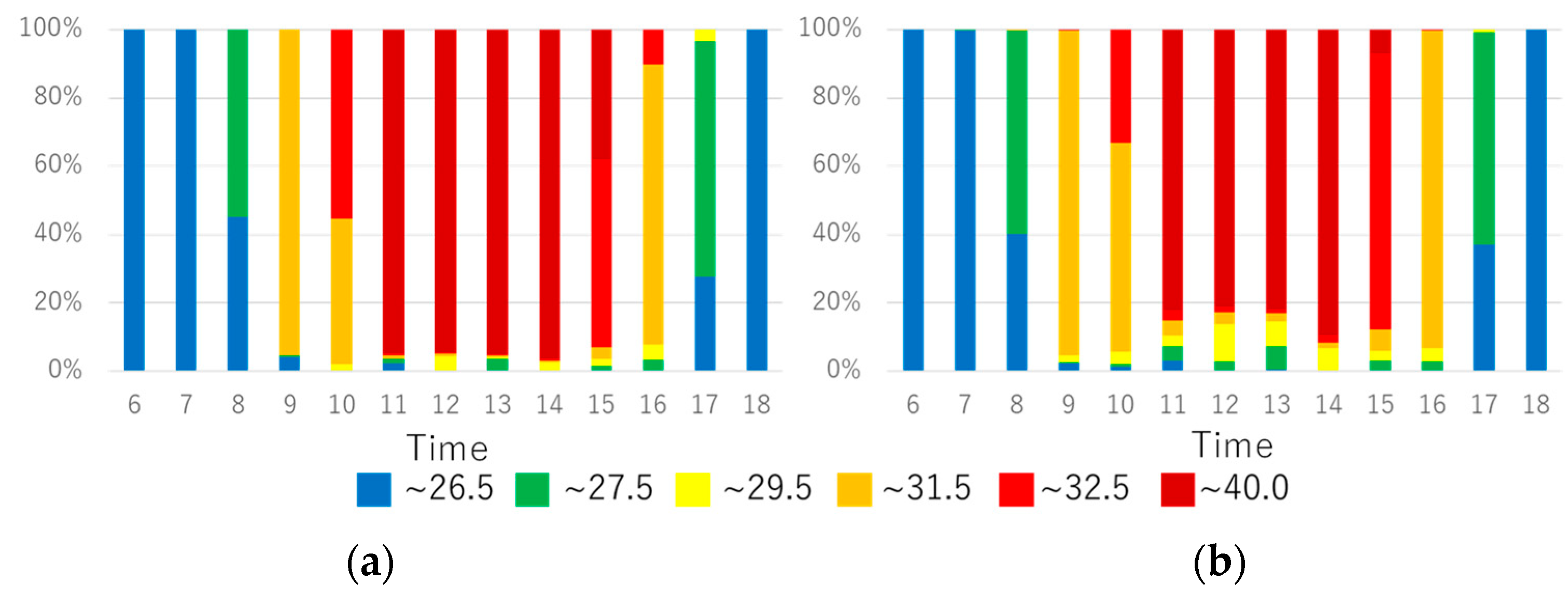

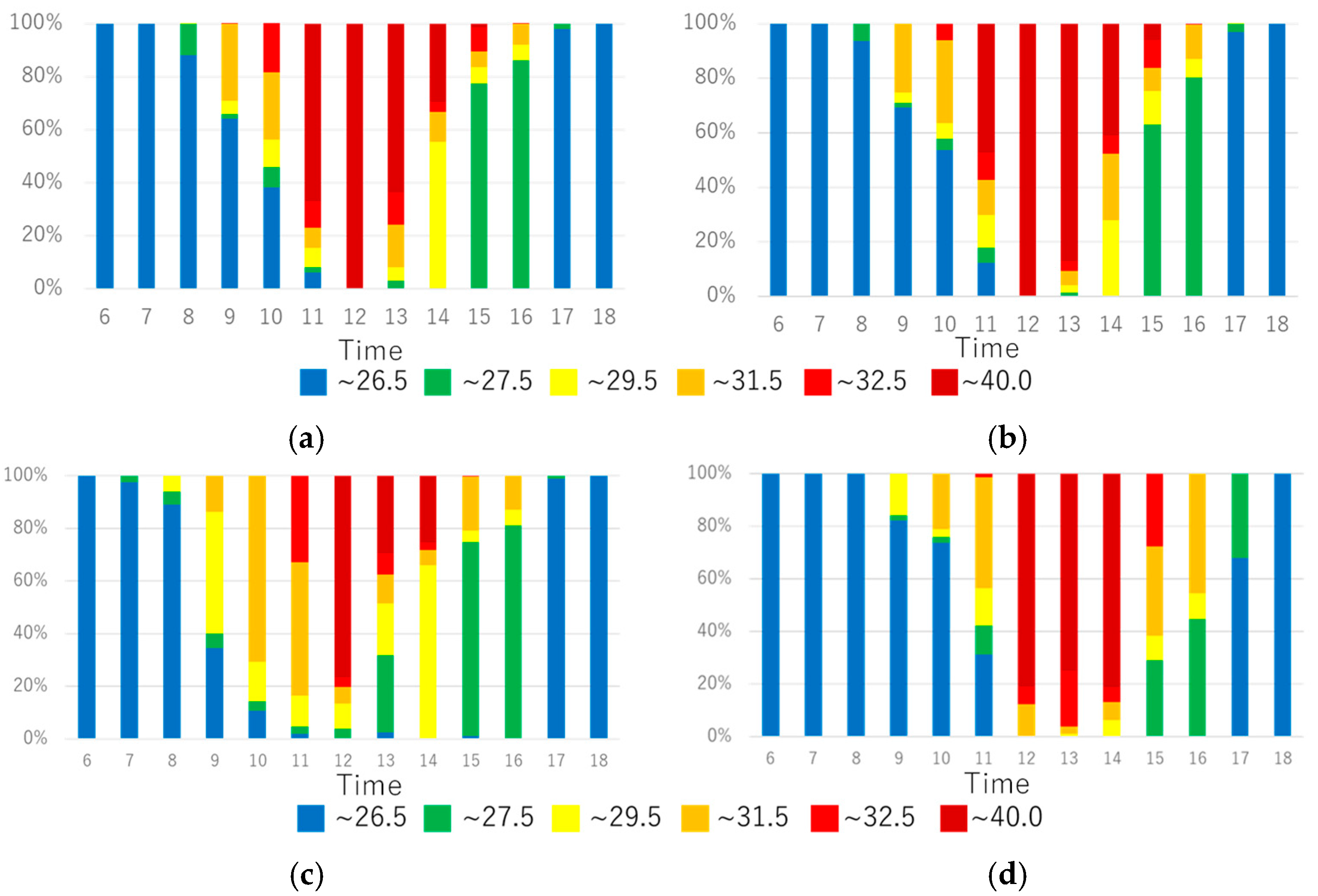
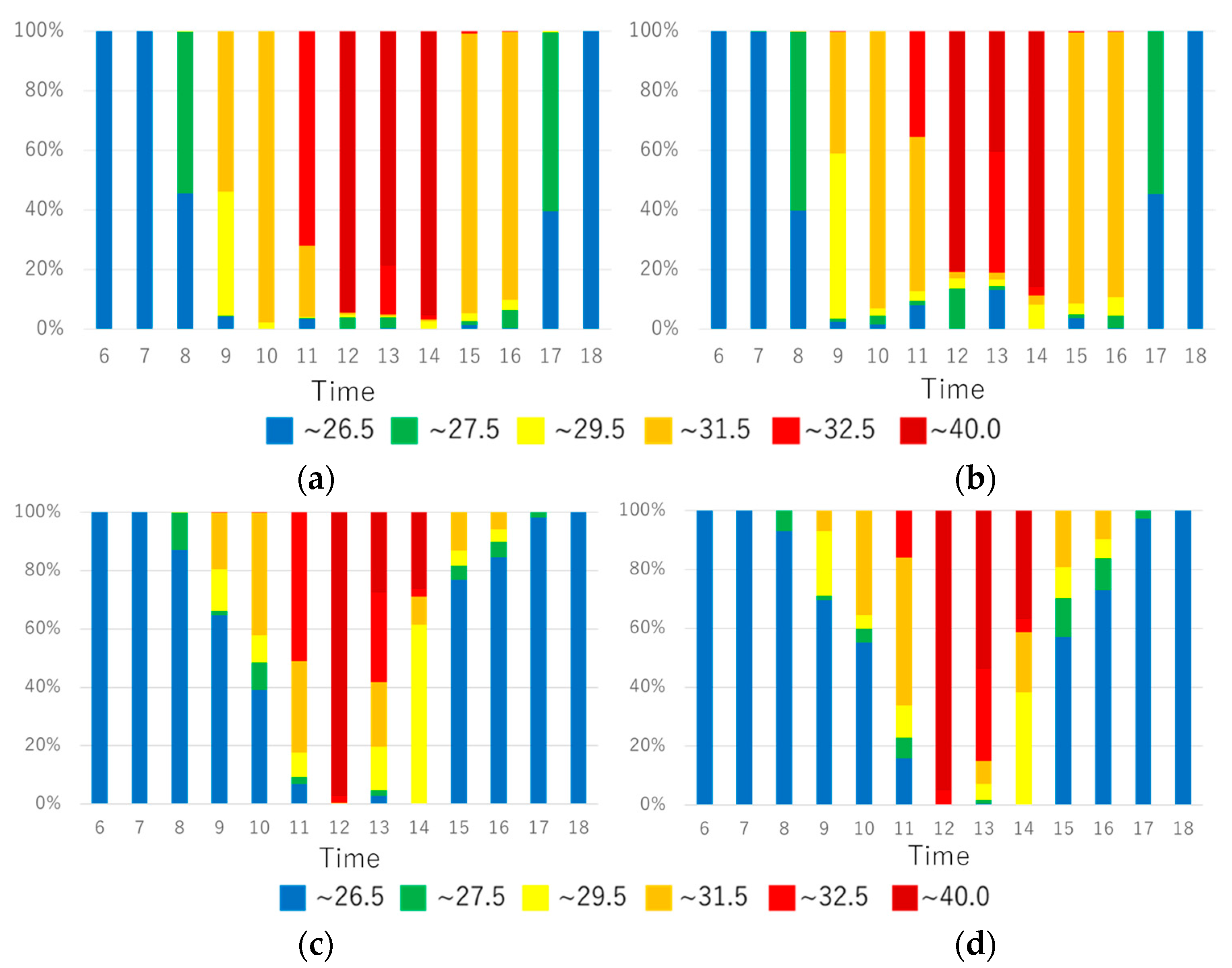


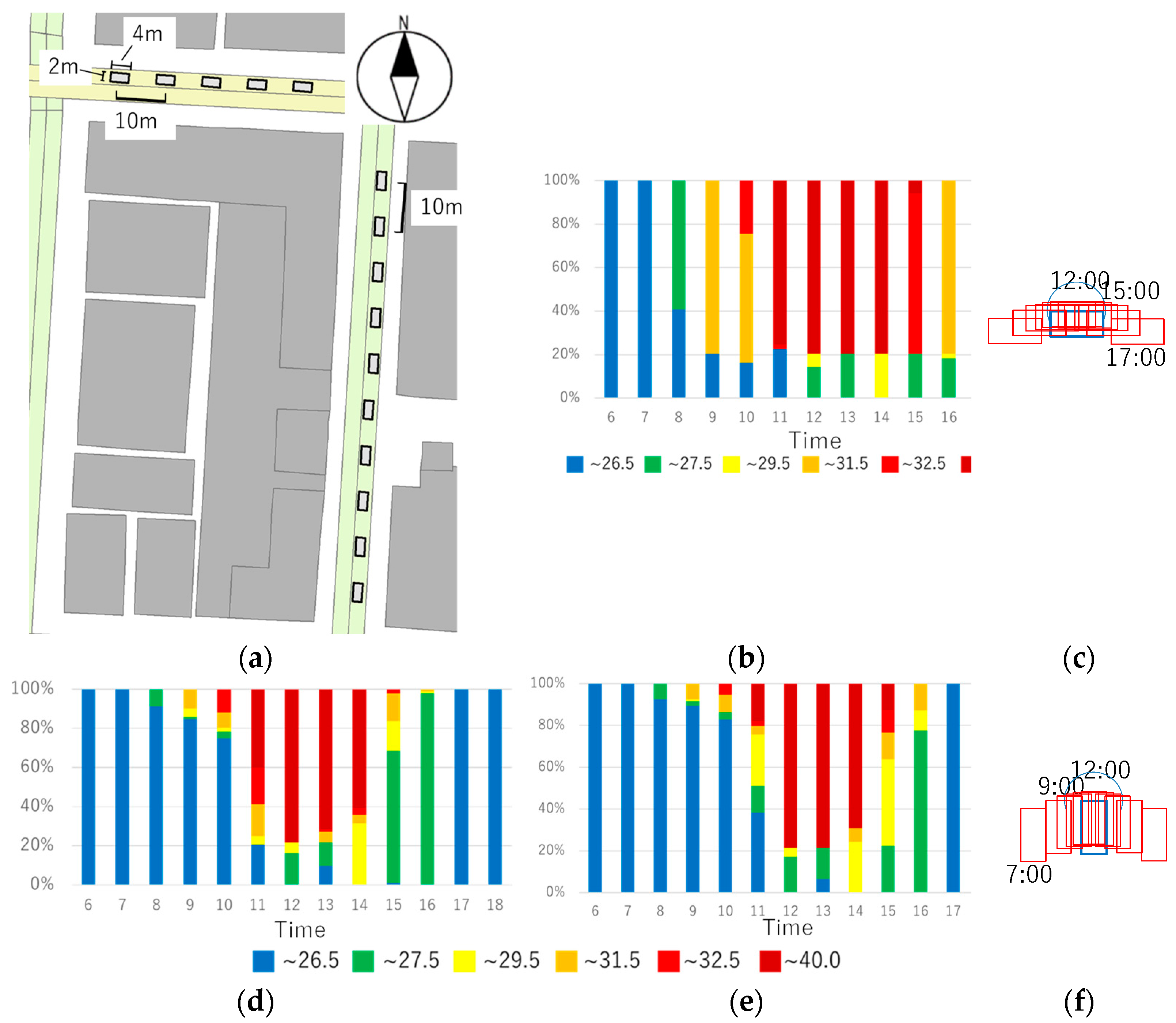
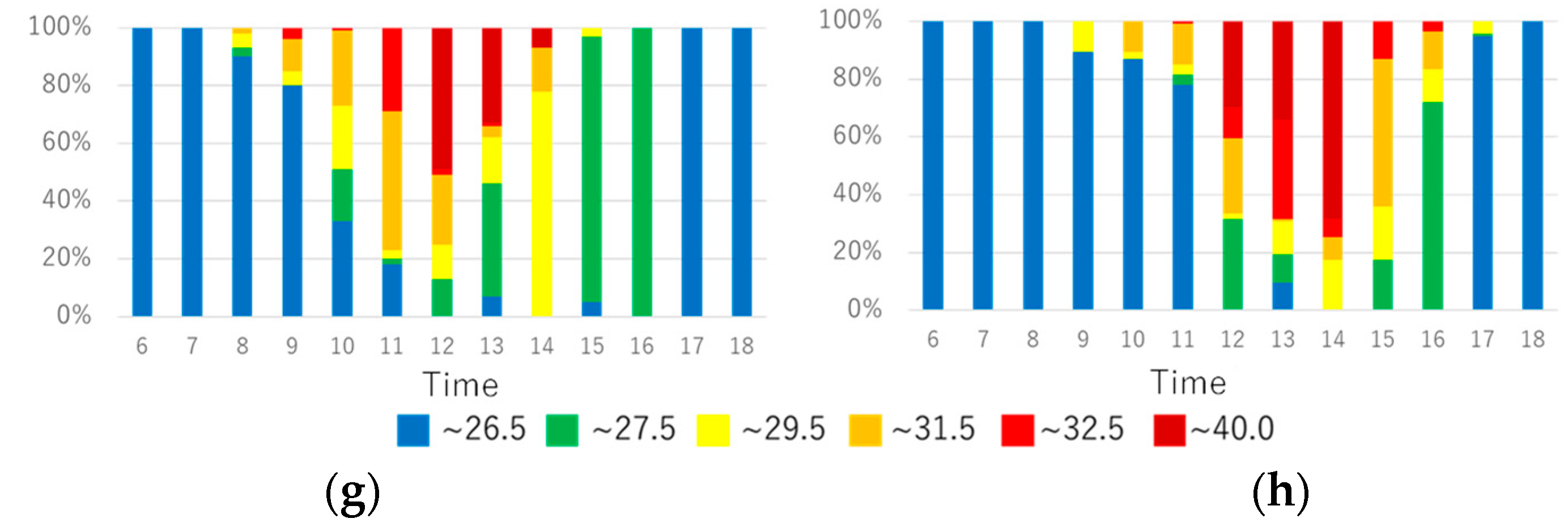

| Solar Reflectance [-] | Evaporative Efficiency [-] | Heat Conductivity [W/(mK)] | Emissivity [-] | Thermal Capacity [kJ/(m3·K)] | |
|---|---|---|---|---|---|
| Concrete | 0.35 | 0.0 | 1.70 | 0.95 | 1934 |
| Grass | 0.30 | 0.3 | 3.00 | 0.90 | 3000 |
| Asphalt | 0.15 | 0.0 | 0.74 | 1.00 | 2056 |
| Soil | - | 0.0 | 0.62 | - | 1583 |
Publisher’s Note: MDPI stays neutral with regard to jurisdictional claims in published maps and institutional affiliations. |
© 2022 by the authors. Licensee MDPI, Basel, Switzerland. This article is an open access article distributed under the terms and conditions of the Creative Commons Attribution (CC BY) license (https://creativecommons.org/licenses/by/4.0/).
Share and Cite
Takebayashi, H.; Danno, H.; Tozawa, U. Study on Strategies to Implement Adaptation Measures for Extreme High Temperatures into the Street Canyon. Atmosphere 2022, 13, 946. https://doi.org/10.3390/atmos13060946
Takebayashi H, Danno H, Tozawa U. Study on Strategies to Implement Adaptation Measures for Extreme High Temperatures into the Street Canyon. Atmosphere. 2022; 13(6):946. https://doi.org/10.3390/atmos13060946
Chicago/Turabian StyleTakebayashi, Hideki, Hiroki Danno, and Ushio Tozawa. 2022. "Study on Strategies to Implement Adaptation Measures for Extreme High Temperatures into the Street Canyon" Atmosphere 13, no. 6: 946. https://doi.org/10.3390/atmos13060946
APA StyleTakebayashi, H., Danno, H., & Tozawa, U. (2022). Study on Strategies to Implement Adaptation Measures for Extreme High Temperatures into the Street Canyon. Atmosphere, 13(6), 946. https://doi.org/10.3390/atmos13060946







